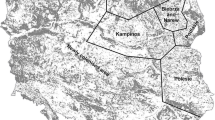Abstract
Analysis of Barí collection of loricarid species suggests that the length of time that has elapsed since each collecting site has last been exploited significantly guides site selection. Information on “patch recovery time,” gathered through intra-village monitoring of independent foraging groups, allows foragers to choose those sites with a high probability of generating good returns. Comparison of actual returns with those predicted by a model of random site selection indicates that the observed pattern of patch exploitation increases the return of kilograms of loricarids for time invested in foraging substantially above that predicted by random returns to sites. The saving of time as well as the increase in food afforded by this system represent currencies for evaluating the value of information on patch recovery time.
Similar content being viewed by others
References
Beckerman, S. (1980). Fishing and hunting by the Barí of Colombia.Working Papers on South American Indians 2: 67–111.
Lizarralde, R., and Beckerman, S. (1982). Historia contemporánea de los Barí.Antropológica 58: 3–51.
Pyke, G. H. (1984). Optimal foraging theory: A critical review.Annual Review of Ecology and Systematic 15: 523–75.
Smith, E. A. (1983). Anthropological applications of optimal foraging theory: A critical review.Current Anthropology 24: 625–649.
Rights and permissions
About this article
Cite this article
Bennett, I.M. Barí loricarid collection and the value of information: An application of optimal foraging theory. Hum Ecol 19, 517–527 (1991). https://doi.org/10.1007/BF00889794
Issue Date:
DOI: https://doi.org/10.1007/BF00889794




